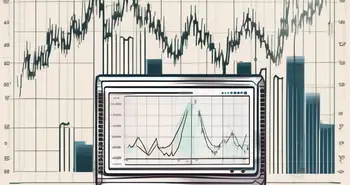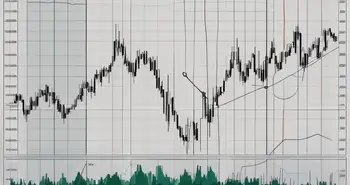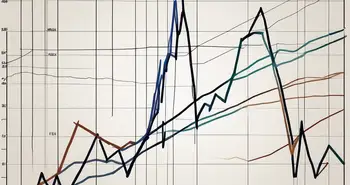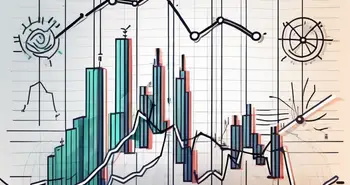The Force Index: Unveiling a Powerful Indicator for Market Analysis

As a seasoned trader, I have come to understand the importance of using reliable indicators for market analysis. One such indicator that has proven to be incredibly effective is the Force Index. In this article, I will delve into the intricacies of the Force Index, its role in market analysis, its advantages, limitations, and provide some expert tips on maximizing its use.
Understanding the Basics of the Force Index
Before we delve into the depths of the Force Index, it is essential to grasp the underlying concept and key components of this powerful indicator.
The Force Index, developed by Dr. Alexander Elder, is a technical analysis tool that combines price movement and volume to measure the strength of bulls and bears in the market. It provides valuable insights into the psychology of market participants and helps identify potential trend reversals.
Dr. Alexander Elder, a renowned trader and author, created the Force Index as a way to quantify the power behind price movements. By incorporating both price and volume data, the Force Index offers a comprehensive view of market dynamics.
The concept behind the Force Index is based on the understanding that price and volume are interconnected. When there is a significant price movement accompanied by high trading volume, it suggests a strong force behind the market action. Conversely, a lack of volume during price fluctuations indicates a weaker force.
The Concept Behind the Force Index
The Force Index, developed by Dr. Alexander Elder, is a technical analysis tool that combines price movement and volume to measure the strength of bulls and bears in the market. It provides valuable insights into the psychology of market participants and helps identify potential trend reversals.
Dr. Elder believed that the Force Index could reveal the underlying power behind market movements, allowing traders to make more informed decisions. By analyzing the relationship between price and volume, the Force Index can indicate whether buying or selling pressure is dominating the market.
Understanding the concept behind the Force Index is crucial for traders looking to incorporate this indicator into their analysis. By recognizing the interplay between price, volume, and market sentiment, traders can gain a deeper understanding of market dynamics and potentially identify profitable trading opportunities.
Key Components of the Force Index
The Force Index consists of three essential components: direction, magnitude, and volume. The direction indicates whether the index is positive or negative, reflecting buying or selling pressure. The magnitude represents the extent of the price and volume movement, while the volume confirms the strength of the price action.
When analyzing the Force Index, it is important to consider the direction of the indicator. A positive reading suggests that bulls are in control, exerting buying pressure on the market. Conversely, a negative reading indicates that bears are dominant, exerting selling pressure.
The magnitude of the Force Index provides further insights into the strength of the price and volume movement. A large magnitude suggests a significant force behind the market action, while a small magnitude indicates a weaker force. Traders can use this information to gauge the intensity of market sentiment and potential trend reversals.
Lastly, the volume component of the Force Index confirms the strength of the price action. High volume during price movements indicates strong participation from market participants, validating the significance of the price movement. On the other hand, low volume during price fluctuations suggests a lack of conviction and potentially a false signal.
By understanding the key components of the Force Index, traders can effectively interpret its readings and incorporate it into their trading strategies. The combination of direction, magnitude, and volume provides a comprehensive view of market dynamics, helping traders make more informed decisions.
The Role of the Force Index in Market Analysis
Now that we have a solid understanding of the fundamentals, let's explore how the Force Index can be utilized to analyze the market and make informed trading decisions.
Identifying Market Trends with the Force Index
The Force Index is an excellent tool for identifying market trends. When the indicator confirms an uptrend, it suggests that bulls are in control, while a confirmed downtrend signals bearish dominance. By following the Force Index, traders can align their strategies with the prevailing market direction, enhancing their chances of success.
Predicting Price Movements Using the Force Index
Another significant advantage of the Force Index is its ability to predict price movements. When the index shows a significant increase in positive or negative magnitude coupled with high volume, it indicates strong buying or selling pressure, respectively. Such occurrences often precede substantial price movements, allowing traders to position themselves advantageously.
Advantages of Using the Force Index
The Force Index offers several advantages that make it an indispensable tool for traders and investors.
Enhancing Trading Strategies with the Force Index
Integrating the Force Index into your trading strategies can significantly enhance profitability. By analyzing the force behind price movements, traders can confirm the validity of signals from other technical indicators, thus increasing the accuracy of their trades.
The Force Index and Risk Management
The Force Index can also serve as a useful tool for risk management. By monitoring the strength of buying or selling pressure, traders can gauge market sentiment and adjust their position sizes accordingly. This helps mitigate potential losses and protects their capital in volatile market conditions.
Limitations of the Force Index
While the Force Index is a powerful indicator, it does have its limitations that traders must be aware of.
Potential Pitfalls of Relying Solely on the Force Index
One common pitfall is relying solely on the Force Index for market analysis. While it provides valuable insights into market strength, it should be used in conjunction with other indicators and analysis techniques to gain a comprehensive understanding of market conditions.
Misinterpretations and Misuse of the Force Index
Another limitation is the potential for misinterpretations and misuse of the Force Index. Traders must take care to understand the indicator's nuances and avoid making impulsive decisions based solely on its readings. It is crucial to consider the broader market context and apply sound judgment when utilizing this indicator.
Tips for Maximizing the Use of the Force Index
To make the most of the Force Index, here are some expert tips to consider:
Combining the Force Index with Other Indicators
By combining the Force Index with other technical indicators such as moving averages, Bollinger Bands, or oscillators like the Relative Strength Index (RSI), traders can gain comprehensive insights into market trends and potential trade setups.
Best Practices for Interpreting the Force Index
It is essential to practice sound interpretation of the Force Index. Avoid jumping to conclusions based on isolated readings and instead focus on longer-term trends. Remember, the force behind price movements is the key, and understanding its magnitude requires a broader perspective.
Now that you have gained a solid understanding of the Force Index, its role in market analysis, advantages, limitations, and expert tips, it is time to implement this powerful indicator in your trading strategy. Remember, the Force Index is not a crystal ball, but when used judiciously, it can unveil market dynamics that may lead to profitable trades. Happy trading!
FAQ
1. What is the Force Index?
The Force Index is a technical analysis indicator that combines price movement and volume to measure the strength of bulls and bears in the market.
2. How can the Force Index be utilized in market analysis?
The Force Index can help identify market trends and predict price movements, allowing traders to align their strategies with the prevailing market direction and position themselves advantageously.
3. What are the advantages of using the Force Index?
The Force Index can enhance trading strategies by confirming the validity of signals from other technical indicators and contribute to effective risk management by gauging market sentiment.
4. What are the limitations of the Force Index?
The Force Index should not be relied upon as the sole indicator for market analysis, and there is the potential for misinterpretation and misuse. It should be used in conjunction with other indicators and analysis techniques.
5. What are some expert tips for maximizing the use of the Force Index?
Traders can maximize the use of the Force Index by combining it with other indicators and adopting best practices for interpretation, such as focusing on longer-term trends and understanding the force behind price movements.
Disclaimer: This article is for informational purposes only and does not constitute financial advice. Trading in financial markets involves risks, and readers should seek professional assistance before making any trading decisions.
Ready to put the Force Index to the test in a trading environment that's as innovative as the strategies you employ? Look no further than Morpher, the revolutionary trading platform that's changing the game with blockchain technology. Experience zero fees, infinite liquidity, and the freedom to trade a myriad of assets—from stocks and crypto to the most unconventional markets. With Morpher, you can start investing with just $1, take advantage of 10x leverage, and enjoy the safety of a non-custodial wallet. Embrace the future of trading with Morpher's unique Virtual Futures and maximize your market analysis with the Force Index. Sign Up and Get Your Free Sign Up Bonus today to elevate your trading to the next level.

Disclaimer: All investments involve risk, and the past performance of a security, industry, sector, market, financial product, trading strategy, or individual’s trading does not guarantee future results or returns. Investors are fully responsible for any investment decisions they make. Such decisions should be based solely on an evaluation of their financial circumstances, investment objectives, risk tolerance, and liquidity needs. This post does not constitute investment advice.

Painless trading for everyone
Hundreds of markets all in one place - Apple, Bitcoin, Gold, Watches, NFTs, Sneakers and so much more.

Painless trading for everyone
Hundreds of markets all in one place - Apple, Bitcoin, Gold, Watches, NFTs, Sneakers and so much more.









